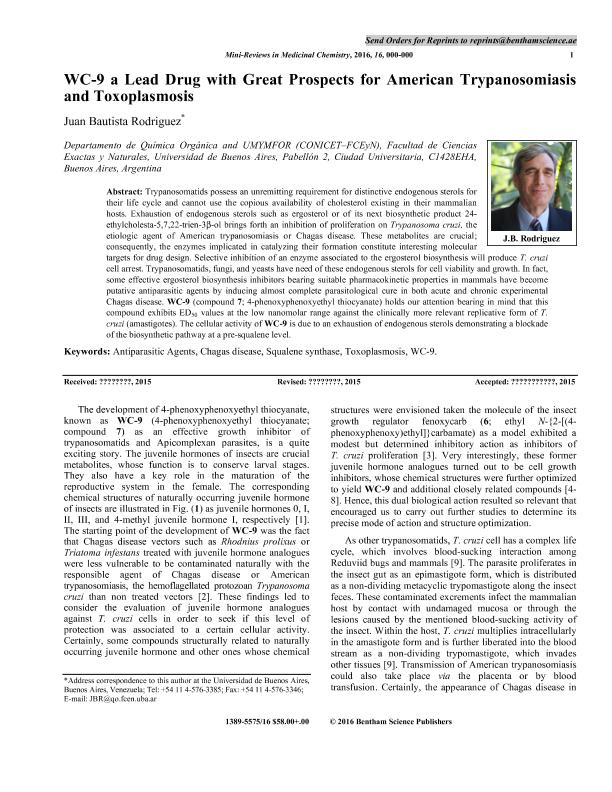Mostrar el registro sencillo del ítem
dc.contributor.author
Rodriguez, Juan Bautista

dc.date.available
2017-06-22T18:10:41Z
dc.date.issued
2016-07
dc.identifier.citation
Rodriguez, Juan Bautista; WC-9 a Lead Drug with Great Prospects for American Trypanosomiasis and Toxoplasmosis; Bentham Science Publishers; Mini-reviews In Medicinal Chemistry; 16; 15; 7-2016; 1-5
dc.identifier.issn
1389-5575
dc.identifier.uri
http://hdl.handle.net/11336/18666
dc.description.abstract
Trypanosomatids have a strict demand for specific endogenous sterols for survival and cannot use the abundant supply of cholesterol present in their mammalian hosts. Depletion of endogenous sterols such as ergosterol or of its next biosynthetic product 24-ethylcholesta-5,7,22-trien-3ß-ol elicits a growth inhibition effect on Trypanosoma cruzi, the etiologic agent of American trypanosomiasis or Chagas disease. These metabolites cannot be replaced by cholesterol; consequently, the enzymes implicated in catalyzing their formation constitute interesting molecular targets for drug design. Selective inhibition of a crucial enzyme associated to the ergosterol biosynthetic pathway in the parasite will arrest T. cruzi proliferation. Trypanosomatids such as T. cruzi as well as fungi and yeasts require these specific endogenous sterols for cell viability and growth. For these reasons, ergosterol biosynthesis inhibitors with potent in vitro activity and appropriate pharmacokinetic properties in mammals have become putative antiparasitic agents by inducing radical parasitological cure in animal models of both acute and chronic experimental Chagas disease. WC-9 (compound 1; 4-phenoxyphenoxyethyl thiocyanate) holds our attention bearing in mind that this compound exhibits IC50 values at the low nanomolar range against the clinically more relevant replicative form of T. cruzi (amastigotes). The growth inhibitory effects of WC-9 are associated with a depletion of the parasite endogenous sterols, ergosterol and its 24-ethyl analogue, indicating a blockade of the biosynthetic pathway at a pre-squalene level.
dc.format
application/pdf
dc.language.iso
eng
dc.publisher
Bentham Science Publishers

dc.rights
info:eu-repo/semantics/openAccess
dc.rights.uri
https://creativecommons.org/licenses/by-nc-sa/2.5/ar/
dc.subject
Trypanosoma Cruzi
dc.subject
Chagas Disease
dc.subject
Wc-9
dc.subject
Squalene Synthase
dc.subject.classification
Química Orgánica

dc.subject.classification
Ciencias Químicas

dc.subject.classification
CIENCIAS NATURALES Y EXACTAS

dc.title
WC-9 a Lead Drug with Great Prospects for American Trypanosomiasis and Toxoplasmosis
dc.type
info:eu-repo/semantics/article
dc.type
info:ar-repo/semantics/artículo
dc.type
info:eu-repo/semantics/publishedVersion
dc.date.updated
2017-06-22T17:38:35Z
dc.identifier.eissn
1875-5607
dc.journal.volume
16
dc.journal.number
15
dc.journal.pagination
1-5
dc.journal.pais
Emiratos Árabes Unidos

dc.journal.ciudad
Sharjah
dc.description.fil
Fil: Rodriguez, Juan Bautista. Consejo Nacional de Investigaciones Científicas y Técnicas. Oficina de Coordinación Administrativa Ciudad Universitaria. Unidad de Microanálisis y Métodos Físicos en Química Orgánica. Universidad de Buenos Aires. Facultad de Ciencias Exactas y Naturales. Unidad de Microanálisis y Métodos Físicos en Química Orgánica; Argentina
dc.journal.title
Mini-reviews In Medicinal Chemistry

dc.relation.alternativeid
info:eu-repo/semantics/altIdentifier/url/http://bsp-cms.eurekaselect.com/index.php/MRMC/article/view/58481
Archivos asociados
